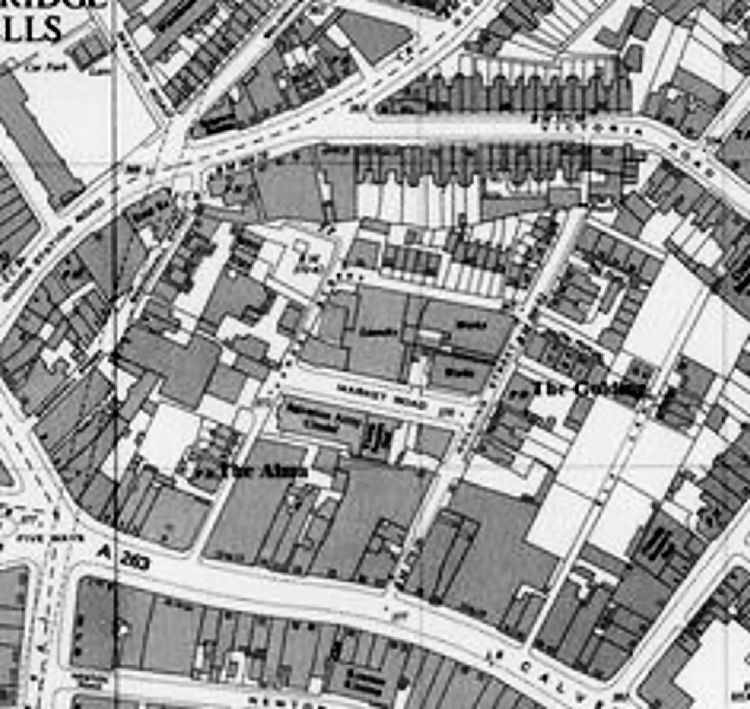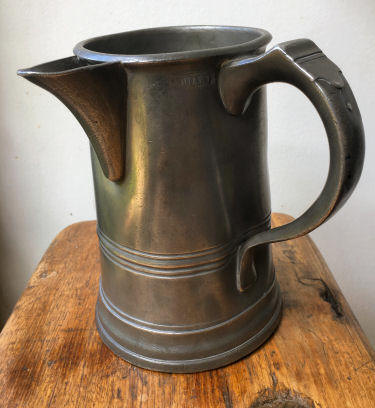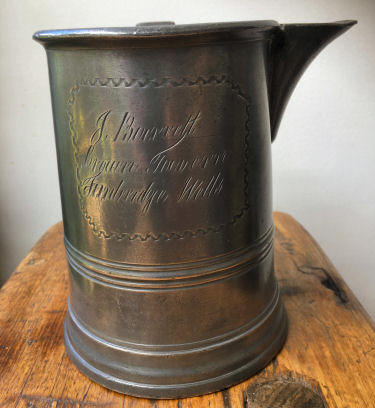|
Written By: Edward James Gilbert-Thunder Bay, Ontario, Canada. Date: January 30, 2017.
THE CROWN TAVERN COMMON LODGING HOUSE.
OVERVIEW.
The Crown at 53 Varney Street was both a tavern and common lodging
house, which in 1911 was described as being premises of 14 rooms. This
red brick building no longer exists, having been demolished by 1982
along with other buildings on the west side of Varney Street.
The first known proprietor of the tavern was Thomas Card who was listed
there as a beerhouse keeper in 1873. At the time of the 1871 census he
was the beerhouse keeper of the "Wheatsheave" pub at 4 Camden Road and by
1877 he had moved from the "Crown" to the "Roebuck Inn" at 81 Camden Road
where he was both a publican and coal merchant employing two men. By
1891 he had given up this business and was a carman living at 26 Albion
Road. He died in Tunbridge Wells in 1901.
A newspaper report dated April 6, 1877 reported that a Mr Roberts had
been charged with assaulting Mrs Caroline Lucy Rabbit, a widow, who was
the proprietor of the "Crown" on Varney Street. She had taken over the
running of this establishment upon the death of her husband George
Rabbit in the 4th qtr of 1875. George Rabbit had been born in Frant in
1827, the son of Robert Rabbit and agricultural worker who’s wife Phoebe
had passed away before 1851. George and Caroline Lucy Couchman had been
married in Tunbridge Wells in 1861 and by 1871 were living at 29 North
Road, Tunbridge Wells with their two daughters. In about 1880 Caroline
left Tunbridge Wells and is found in the 1881 census in Rotherfield,
Sussex where she was the beerhouse keeper of a local pub. Caroline died
in Paddington, London in 1901.
In about 1880 the "Crown" was taken over by James Barrett (1846-1905) who
had been born in Cork Island. James was the son of William Barrett, an
agricultural labour and Anne Barrett. James was married but his wife
died sometime before 1881. In 1881 his premises were called ‘The Crown
Tavern Common Lodging House’ and crammed in there were 24 lodgers. At
the time of the 1891 census he had 14 lodgers and about the same in
1901. James died at the "Crown Tavern" in 1905.
The last known keeper of these premises was Albert John Skinner who was
listed there in the 1911 census and the1913 Kelly directory but was gone
by 1922. Albert had been born in 1884 at Canterbury, the son of John and
Esther Skinner. He was married in 1908 to Ellen Leaney, born in 1891 and
by 1911 the couple had one daughter. In 1911, in addition to his
family, were living 22 boarders in 14 rooms. He died in Thanet, Kent in
1975.
In November of 1912 a large gathering of the Tunbridge Wells branch of
the National Union of Women Workers (NUWW) assembled to discuss the poor
provision of women-only Common Lodging House places.
In 1913 this tavern and lodging house was put up for sale. The house
accommodated 28 people in 8 bedrooms, with a bar and a small kitchen for
lodgers who paid between 6d and 10d a night. The aim of the NUWW was to
purchase the house and re-open it as a Common Lodging house for women
and children only.
The purchase price of £1,600 was raised through the sale of £1 shares,
and Tunbridge Wells Common Lodging Houses Ltd was formed. The premises
were renovated, cleaned, and transformed into the "Crown Lodging House
for Women and Children" which was opened in a ceremony performed by the Mayoress in July 1913. The Kent & Sussex Courier of July 25, 1913 gave
the following account pertaining to this building under the heading "The Old Crown Tavern in Varney Street is now transformed, almost out of
recognition". Mr. E. Brotherton, one of the directors of Tunbridge Wells
Common Lodging Houses Ltd, paid tribute to Amelia Scott who, he said
'had worked so hard in the matter'.
Now no longer a tavern this Women and Children lodging house continued
in operation for several years. How long it remained in this use was not
established and the history of the building since they took over in 1913
up to the time of the buildings demolition circa 1980. No mention of
this building was found in the records of the Planning Authority from
1975 onwards and so no clues about the building from this source were
found but it is known that the "Alma Tavern" at 7 Varney Street was still
there, with presumably the "Crown" and other buildings in the area in
1979.

Shown above is a map from 1982 showing Varney Street on which
is highlighted in red the location of the
Alma Tavern at No. 7. As can
be seen from this map all of the buildings on the west side of Varney
Street had been demolished by that time.
THE COMMON LODGING HOUSE.
"Common lodging-house" is a Victorian era term for a form of cheap
accommodation in which inhabitants are lodged together in one or more
rooms in common with the rest of the inmates, who are not members of one
family, whether for eating or sleeping. The slang term flophouse is
roughly the equivalent of common lodging-houses. The nearest modern
equivalent is a hostel.
There was no statutory definition of the class of houses in England
intended to be included in the expression common lodging-house, but the
definition used above was adopted to include those houses which, under
the Public Health Act 1875 and other legislation, must be registered and
inspected. The provisions of the Public Health Act were that every urban
and rural district council must keep registers showing the names and
residences of the keepers of all common lodging-houses in their
districts, the location of every such house, and the number of lodgers
authorized by them.
The scandalous condition of the common lodging houses in London, which
were frequently the resort of criminals and prostitutes, prompted the
Common Lodging Houses Acts 1851 and 1853. These regulations, however
proved ineffectual and the requirement that residents vacate the
premises between 10 a.m. and late afternoon hit poor and sick residents
hard, as they were obliged to walk the streets in the intervening period
in all weathers.
Even tighter control was imposed when regulation of common lodging
houses was transferred from the police to the London County Council in
1894, resulting in the imposition of higher standards and regular
inspection of the premises by council officials. The new regulations
required the landlords to limewash the walls and ceilings twice a year
and the mixed sex accommodation, which was frequently a cover for a
brothel, was abolished. Proper beds and bedding had also to be provided
instead of mattresses on the floor and worse.
[1] THOMAS CARD
Thomas Card was born 1834 in Withyham, Sussex. He
was baptised there in October 5, 1834, one of several children born to
George and Anne Card. Thomas was still living at Withyham up to the time
of his marriage there on November 10, 1855 to Jane Box (1834-1913). Jane
had been born in Withyham, Sussex and was the daughter of William Box.
Thomas and his wife went on to have six children and it can be seen that
the family moved to Tunbridge Wells by 1869 for in that year they had s
son William (1869-1898) and a son Walter (1879-?) both born in Tunbridge
Wells. The 1871 census, taken at the ‘Wheatsheave’ pub at 4 Camden Road,
gave Thomas as a beerhouse keeper. With him was his wife Jane and three
of their children. A local directory of 1873 gave Thomas as the
beerkeeper of the Crown Tavern on Varney Street but was gone by about
1875. The 1881 census gave Thomas as a publican and coal merchant
employing two men while at the Roebuck Inn at 81 Camden Road. With him
was his wife Jane; three of their children, and one domestic servant.
The 1891 census, taken at 26 Albion Road, Tunbridge Wells, gave Thomas
as a carman. With him was his wife Jane, their son Walter, and one
visitor. Thomas died in Tunbridge Wells January 21, 1901. The executor of
his £2,324 estate was Henry Dainton, a retired brewer’s agent.
[2] GEORGE AND CAROLINE RABBIT
Several variations in the spelling of this families surname were found
but ‘Rabbit’ appears to be the most reliable.
George Rabbit had been born 1827 in Frant, Sussex. He had been baptised
in Frant July 29,1827 and was one of several children born to Robert and
Phoebe Rabbit. He was still living in Frant with his parents and
siblings at the time of the 1841 census. The 1851 census, taken at the
cottages in Frant gave Robert Rabbit as age 47, a widower working as an
agricultural labourer. Also there were seven other Rabbit children and
one granddaughter. In the 4th atr of 1861 George married Caroline Lucy
Couchman in Tunbridge Wells. Caroline had been born 1827 in Tunbridge
Wells. The 1871 census, taken at 29 North Road, Tunbridge Wells gave
George Rabbit as a beerhouse keeper. With him was his wife Caroline;
their two daughters Fanny, born 1858 and Jane, born 1861 and six
lodgers. Soon after took over the running of the Crown on Varney Street
and in the 4th qtr of 1875 he died there. Upon his death his widow
Caroline took over the establishment. A newspaper report dated April
6, 1877 reported that a “Mr Roberts had been charged with assaulting Mrs
Caroline Lucy Rabbit, a widow, who was the proprietor of the Crown on
Varney Street”. In about 1880 Caroline left Tunbridge Wells and is found
in the 1881 census in Rotherfield, Sussex where she was the beerhouse
keeper of a local pub at or near Green Hill. With her was her niece, one
boarder, two visitors and one domestic. Caroline died in Paddington,
London in 1901.
[3] JAMES BARNETT
James Barnett took over the Crown Tavern and Common Lodging House from
Caroline Lucy Rabbit circa 1880. James had been born 1846 in Cork,
Ireland and was still in Ireland up to at least 1851. The 1861 census,
taken at 3 Isabella Place in Putney, Surrey, gave William Barrett (his
father) as a labourer born 1821 in Cork, Ireland. With him was his wife
Anne, born 1821 in Cork and their two sons John, born 1849 in Cork and
James born 1846 in Cork. The 1881 census, taken at 53 Varney Street
Crown Tavern and Common Lodging House gave James and a laundress and
twenty four lodgers there, most of whom were hawkers and dealers. James
had been married but his wife had passed away by that time and he
appears not to have had any children. The 1891 census, taken at the same
place gave John as widowed and working as a beerhouse and lodging house
keeper. With him were 14 lodgers. He was still running this
establishment at the time of the 1901 census. Probate records gave James
Barrett of the Crown Tavern on Varney Street when he died March 26, 1905.
The executor of his 985 pound estate was Julia Lynch, widow.
[4] ALBERT JOHN SKINNER
Albert took over The Crown pub and lodging house upon the death of James
Barrett in 1905. Albert was born in the first qtr of 1884 at
Canterbury, Kent. He was baptised November 2, 1884 at Canterbury and was
one of several children born to John Skinner (1837-1898) and Esther
Skinner, nee Failkner (1842-1910). In 1885 Albert was living in
Canterbury. The 1891 census, taken at 20 King Street (The Farriers Arms)
at St Alphage, Kent, gave John Skinner as the licensed victualler. With
him was his wife Esther; three of their children including Albert; one
niece and 31 boarders. In 1908 Albert married Ellen M. Leoney, the
daughter of James and Sarah E. Leoney. She was living with her parents
at 11 Balmoral Street in Ash, Surrey at the time of the 1901 census, and
at that time Ellen was working as a drapers apprentice. She had been
born 1891 in Oxfordshire. Her father was a railway guard. The 1911
census, taken at 53 Varney Street gave Albert as a publican and lodging
house keeper. With him was his wife Ellen and their only child, Minnie
Kathleen Skinner (1897-1993) who had been born in Oxfordshire. Also there
,in premises of 14 rooms, were 22 lodgers. Albert John Skinner was still
listed at 53 Varney Street in the 1913 Kelly directory but in that year
the Crown Tavern and Common Lodging house was put up for sale and
purchased by the Tunbridge Wells Common Lodging Houses Ltd who converted
the building into a lodging house for women and children, details of
which are given in the last section of this article.
THE LADY’S LODGING HOUSE
The following information is from the website ‘Inspiring Women’.
Life in pre-First World War Tunbridge Wells was not comfortable for
everyone. Those who had to travel from place to place for work were
reliant on common lodging houses for their overnight accommodation, as
they frequently were unable to pay the 1 shilling per night charge for
other types of lodgings. Four of the common lodging houses in Tunbridge
Wells were also licensed premises; the "Crown" and the "Alma" in Varney
Street, the "Dorset Arms" in Golding Street and the
"Standard" in Little
Mount Sion. Three of these provided mixed accommodation which meant
shared washing facilities. Young unmarried women were not admitted at
all. It was feared that women would often prefer to stay in the casual
wards of the workhouses than to face the degradation of mixed lodging
houses.
In November 1912, a large gathering of the Tunbridge Wells branch of the
National Union of Women Workers assembled to discuss the poor provision
of women-only Common Lodging House places. Whilst a relatively small
number of women used them, even as few as six a week added up to two
thousand a year, and therefore to a significant social problem. The
NUWW’s letters to magistrates, together with those from other agencies
asking that the premises’ licenses be withheld, had previously fallen on
deaf ears.
The following year, the Crown’s owners put the building up for sale. The
house accommodated 28 people in 8 bedrooms, with a bar and a small
kitchen for lodgers who paid between 6d and 10d a night. The aim of the
NUWW was to purchase the house and re-open it as a Common Lodging house
for women and children only.
The purchase price of £1,600 was raised through the sale of £1 shares,
and Tunbridge Wells Common Lodging Houses Ltd was formed. The premises
were renovated, cleaned, and transformed into the Crown Lodging House
for Women and Children which was opened in a ceremony performed by the
Mayoress in July 1913. In his speech at the opening ceremony, Mr. E.
Brotherton, one of the directors of Tunbridge Wells Common Lodging
Houses Ltd, paid tribute to Amelia Scott who, he said 'had
worked so hard in the matter'.”
The Women’s Library has in their collection the ‘Tunbridge Wells Common
Lodging Houses By-laws (1870).
The Kent & Sussex Courier of July 25, 1913 gave the following account
pertaining to this building under the heading “The Old Crown Tavern in
Varney Street is now transformed, almost out of recognition”.
The Royal Tunbridge Wells Civic Society newsletter of Autumn 2003
contained an article entitled ‘Low Life in Victorian Times’ which in
part stated “In the 1860’s -1880’s the areas of town to avoid, if you
belonged to polite society, were Golding Street, Varney Street,
Bassinghall Lane, Ely Lane, Goods Station Road and that part of St
John’s Road known as the ‘Lew’. Much of this area has disappeared
beneath the Royal Victoria Place. Beerhouses were two in a penny in some
parts of town. On Varney Street there were two, the "Crown" at 53 Varney
Street and the "Alma" at 7 Varney Street with fights and foul language
being common at both of them. Hardly the place for a women’s lodging
house it would seem. The Salvation Army Citadel was also on Varney
Street and no doubt they were busy saving souls given the rough types
living in the area.
|


